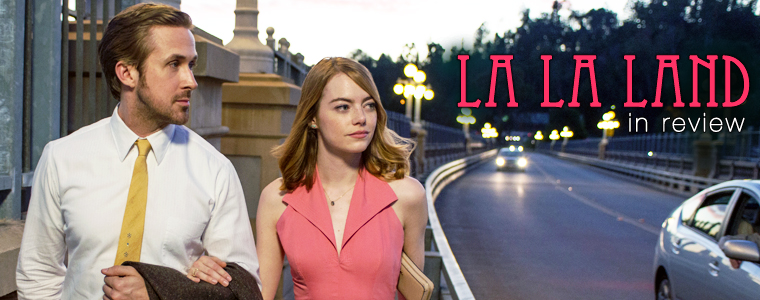Crazy As They May Seem
by Andrew Collins
The young auteur, Damien Chazelle, announced his talent to the world with a crash and a bang—literally—in the festival circuit with 2014’s Whiplash, a dark tale of a relentlessly ambitions jazz drummer and his abusive instructor at New York’s prestigious Shaffer Conservatory. The film wrung the best out of rising star Miles Teller and gave us as memorable a performance from J.K. Simmons as the stalwart actor has ever offered.
Now, Chazelle is back with La La Land, a decidedly more sunny, but no less serious, story about the price of success. The film is set on the opposite coast from Whiplash, in America’s other center of media production: Los Angeles. Dripping with the bright energy of Hollywood, the rainbow of cultural diversity found in any rush hour traffic jam, and the classy nostalgia of jazz, the City of Angels has never looked – or felt – better.
The outlandish opening, a lengthy sing-shot dance number on one of the city’s signature highway overpasses, sets the stage for the film’s brilliance. La La Land is fantastically whimsical, indulging in the stickiest and sweetest sentimentality Los Angeles has to offer, but it also critiques the very dreams that Hollywood loves to stir up in us. The harsh reality for the 21st Century couple is that true love comes with a price. Rarely, if ever, has it been sustained alongside the pursuit of professional success.
The film tells the story of a star-crossed romance between Mia (Emma Stone), an aspiring actress who works at a coffee shop to make ends meet, and Sebastian (Ryan Gosling), a struggling jazz musician who must descend to playing pool party gigs in an eighties cover band to stay afloat. Mia dreams of writing and starring in her own productions. Seb dreams of owning his own jazz club. The improbable match starts with cliche flirting. Mia hates jazz. Seb woos here to the genre at one of his favorite clubs. And soon enough we find the mushily in-love couple dancing among the stars.
Yes, the tropes are on display, but they’re artfully dolled out in just the right doses, from a standoffish duet overlooking Hollywood to a fanciful late night drive up to Griffith Observatory. As Mia and Seb’s relationship develops, it carries the aura of being in love, but at the same time there’s a sense that eventually the other shoe’s going to drop. It does, of course, but Chazelle is careful in the meantime not to let this sense of foreboding drown out the fun.
The tone of the film shifts as the story journeys from the land of broke dreamers to the pragmatic machinations of artists who, having achieved better-than-average success in their field, suddenly find themselves caught up in the drudgery of negotiating contracts and showing up for photo shoots. Tensions flare, and the musical numbers become less frequent and less grandiose until nothing remains but Mia humming a lonely toast to the fools who dream as she auditions for the lead role in an avant-garde film set in Paris.
“Here’s to the one’s who dream, crazy as they may seem,” she sings. “Here’s to the hearts that break. Here’s to the mess we make.”
Success comes, but it makes a mess, and the singing stops. La La Land ends with an ambiguous conclusion that is unambiguously heart-wrenching no matter how one reads it. Perhaps the best term to use for it is that deep sense of “happy-sad” described by Raphina in Sing Street. The feeling doesn’t go away in a hurry, and it leaves us all to wonder: Who is the greater fool? The one who simply dreams big dreams of beauty and fame, or the one who follows those dreams at the risk of the most important person in the world?








